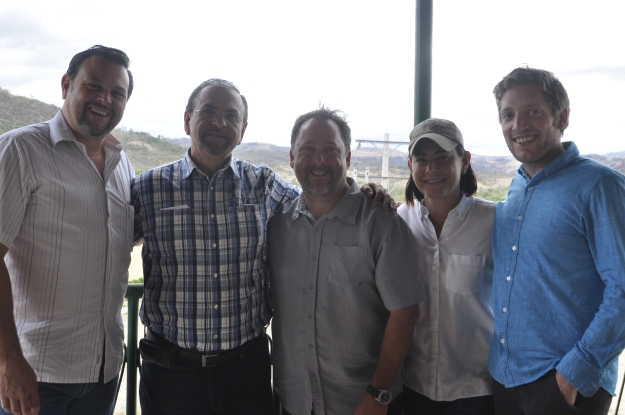Coming back to El Salvador this year felt like a homecoming and a visit to a dear friend; the people and places have become familiar and intimate.
Our major project here is with the Ortiz, Mendez family who own Finca Talnamica and Natamaya; we’ve been in close contact with them for the past year discussing our plan for this year’s harvest. Our approach for 2012-13 has been to separate out as many lots as possible so that we can cup through the harvest and identify plots and lots of coffee that are exceptional. We’ve teamed up with Emilio Lopez of Cuatro M to facilitate the processing, lot tracking, and dry milling. As a result, the coffees this year are scoring higher and have better depth and complexity.
Beyond securing high quality lots, our aim for working directly with producers is to do our part to help coffee communities and to give back to those who make our delicious beverage possible. To that end, we’ll be launching a program this year in our cafes where $1 per bag of Natamaya coffee will go directly to a foundation to aid the community Canton Ojo de Agua. The remote community has a small school and we hope to help them convert the neighboring plot from a dry, uneven dirt field to a nice soccer field for the kids. As the project evolves, we’ll keep posting updates on our Facebook and Twitter pages.
Here are some pictures from our travels in El Sal:

Morning coffee up at the Finca Talnamica farm house


Farm manager Miguel Angel of Talnamica

The beautiful Finca Talnamica farmhouse where we stayed for several days.

Beautiful natural shading over the nursery at Talnamica

Driving through Juayua on our way to Cuatro M and Natamaya

The ‘curtains’ used as windbreakers in El Sal

In Rene Linares’s garden near Finca Natamaya. Rene is a powerhouse for helping the community move forward and was extremely hospitable and gracious during our visit.

The man behind Cuatro M beneficio and Finca El Manzano, Emilio Lopez, looks over his farm as he talks with us about our project.

Bathrooms by the school in Canton Ojo de Agua by Natamaya.

The site we plan to help convert to a soccer field.
One of my biggest takeaway feelings from El Salvador has been how hard-working, kind and compassionate the people are.
At Talnamica, Tita overees the home and cooking, but for us she also did so much more. I came down with a stomach bug on Sunday and she looked after my every need to make sure I recovered quickly. She also washed our clothes and boiled water for us to bathe with. I decided to start calling her ‘Tía Tita,’ which means ‘Aunt Tita’ in Spanish because she’s just so amazing (she’s also one hell of a cook).
At Cuatro M Emilio and his staff let us into their space and assured us time and time again that it was our house to use as we needed. I roasted 27 batches on his roaster, his staff Jasmin and Diego set up cuppings for us, Emilio gave us his precious time to tour the facility and chat with us about our goals and ideas. I’m so grateful for their hospitality; our trip wouldn’t have been the same without it.
Mayita, daughter of Herman and Nena Ortiz who own Finca Natamaya, spent all 5 of our El Sal days with us visiting farms, helping us navigate, and sharing her homes with us. We wrapped up our stay in El Sal with a beautiful day at the beach at her aunt’s house that replenished our energy and further cemented our friendship and professional bond.
Great quality, sustainable coffee is all about collaboration and cooperation. So many things have to line up for the harvest to work well, for people to remain happy, and for everyone to see the common goal. I’m so grateful for our producer partners here and can’t wait to share their hard work with our customers and staff.
-Jared Linzmeier
Director of Coffee




























